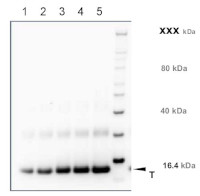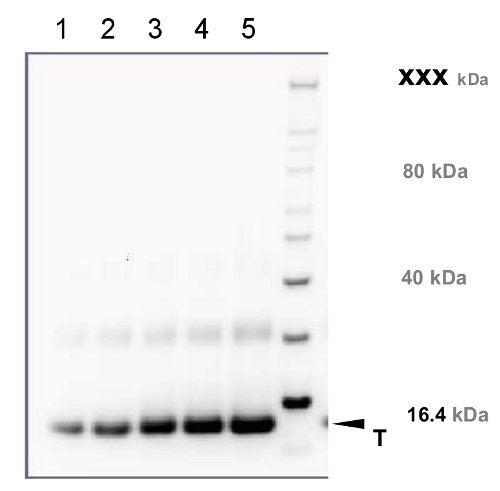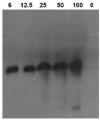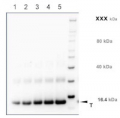1

PR-1 | Positive control/quantitation standard
AS10 687S | Recombinant protein standard for quantification and positive control, for use in Western blot.
- Data sheet
- Product Info
-
Format: Lyophilized in glycerol. Quantity: 100 µl Reconstitution: For reconstitution add 90 µl of sterile water, Please notice that this product contains 10% glycerol and might appear as liquid but is provided lyophilized Storage: Store lyophilized/reconstituted at -20°C; once reconstituted make aliquots to avoid repeated freeze-thaw cycles. Please remember to spin the tubes briefly prior to opening them to avoid any losses that might occur from material adhering to the cap or sides of the tube. Tested applications: Western blot (WB) Recommended dilution: Standard curve: 3 loads are recommended eg. 0.5, 2 and 4 μl.
For most applications a sample load of 10-20 μg of protein will provide with a signal in this range.
Positive control:a 2μl load per well is optimal for most chemiluminescent detection systems.
This standard is stabilized and ready and does not require heating before loading on the gel. For use in Western blot applications only.
Please note that this product contains 10% glycerol and might appear as liquid but is provided lyophilized. Allow the product several minutes to solubilize after adding water. Mix thoroughly but gently Take extra care to mix thoroughly before each use, as the proteins tend to settle with the more dense layer after freezing.
Expected | apparent MW: 16.4 kDa - Application Examples
-
Application example 
Recombinant PR-1 protein standard 0.05 pmol (1), 0.1 pmol (2), 0.15 pmol (3), 0.2 pmol (4), and 0.3 pmol (5) was loaded in each lane. Protein separation was done using NuPage 4-12% Tris-Bis gel (Invitrogen) LDS-PAGE and blotted 1h to PVDF. Blots were blocked immediately following transfer in 2-2.5 % RPN2125 (GE Healthcare) in 20 mM Tris, 137 mM sodium chloride pH 7.6 with 0.1% (v/v) Tween-20 (TBS-T) for 1h at room temperature with agitation. Blots were incubated in the primary anti-PR-1 antibody at a dilution of 1: 10 000 in blocking reagent for 1h at room temperature with agitation. The antibody solution was decanted and the blot was rinsed briefly twice, then washed once for 15 min and 3 times for 5 min in TBS-T at room temperature with agitation. Blots were incubated in secondary antibody (anti-rabbit IgG horse radish peroxidase conjugated, recommended secondary antibody AS09 602) diluted to 1:25 000 in TBS-T for 1h at room temperature with agitation. The blots were washed as above and developed for 5 min with chemiluminescent detection reagent in extreme low femtogram range, according the manufacturers instructions. Images of the blots were obtained using a CCD imager (FluorSMax, Bio-Rad) and Quantity One software (Bio-Rad). Exposure time was 1 minute.
- Additional Information
-
Additional information: The PR-1 protein standard can be used in combination with anti-PR-1 antibodies to quantitate PR-1 protein. Quantitative western blot: detailed method description, video tutorial
This product can be sold containing ProClin if requestedAdditional information (application): Concentration: after adding 90 µl of sterile milliQ water final concentration of the standard is 0.10 pmoles/µl
Protein standard buffer composition: Glycerol 10%, Tris Base 141 mM, Tris HCl 106 mM, LDS 2%, EDTA 0.51 mM, SERVA® Blue G250 0.22 mM, Phenol Red 0.175 mM, pH 8.5, 0.1mg/ml PefaBloc protease inhibitor (Roche), 50mM DTT.
This standard is ready-to-load and does not require any additions or heating. It needs to be fully thawed and thoroughly mixed prior to using. Avoid vigorous vortexing, as buffers contain detergent. Following mixing, briefly pulse in a microcentrifuge to collect material from cap.
This standard is stabilized and ready and does not require heating before loading on the gel.
Please note that this product contains 10% glycerol and might appear as liquid but is provided lyophilized. Allow the product several minutes to solubilize after adding water. Mix thoroughly but gently Take extra care to mix thoroughly before each use, as the proteins tend to settle with the more dense layer after freezing.
- Background
-
Background: Pathogenesis-related protein 1 (PR-1) is partially responsible for acquired pathogen resistance. Induced by INA, salicylic acid and pathogen infection.
This product is a recombinant PR-1 protein, trunctated by first 26 amino acids, source: Arabidopsis thaliana, UniProt: P33154, TAIR: At2g14610 - Protocols
-
Agrisera Western Blot protocol and video tutorials
Protocols to work with plant and algal protein extracts
Agrisera Educational Posters Collection
- Reviews:
-
This product doesn't have any reviews.
Accessories

AS07 207 | Clonality: Polyclonal | Host: Rabbit | Reactivity: A. stolonifera cv. ‘Penncross’, C. annuum, N. tabacum, P. abies, S. esculentum, S. lycopersicum, S. tuberosum, V. vinifera | Cellular marker of vacuolar contents


